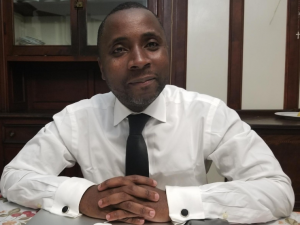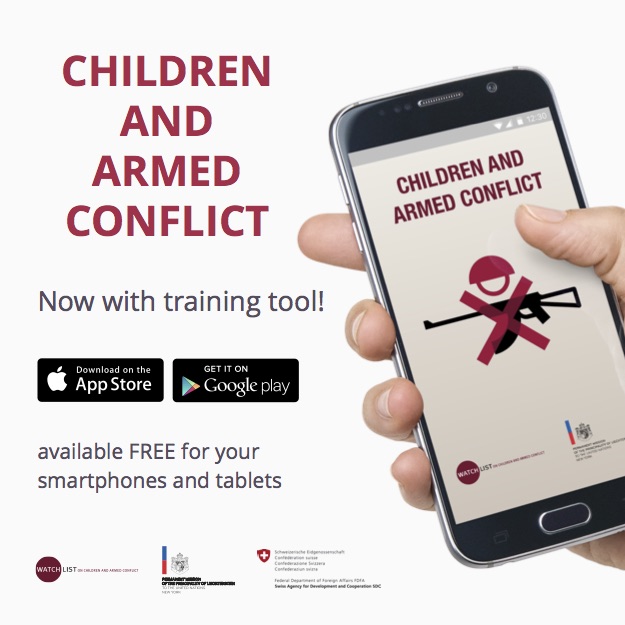
In March 2018, Watchlist welcomed its new executive director Bukeni Waruzi. Originally from the Uvira territory in the Eastern Democratic Republic of Congo (DRC), Bukeni is the founder and former executive director of AJEDI-Ka/Projet Enfants Soldats, a grassroots organization working to prevent the recruitment and use of children by armed groups in the DRC and support their demobilization and reintegration. He also worked at WITNESS as the senior program manager for Africa and the Middle East, where he led the organization’s Global Campaign on Sexual and Gender-Based Violence. Bukeni recently spoke with staff and interns about his previous experience, motivations, and visions for the future of Watchlist.
When did you start working in human rights, and what motivated you to do so?
My work in human rights began in early 1998, after the war in the DRC had started affecting my hometown. I was studying economics and planned to work for a company, but then I witnessed many kids being abducted by militias, rebel groups, and the national army for recruitment. The majority of the children being recruited were between 10 and 12. As I was wondering what to do, some of the parents came to me because I spoke French and asked me to talk to the commanders who were recruiting children to find out whether their children were alive or not. That call was the beginning of my career. When I formed AJEDI-Ka/PES with a few friends, our initial activities involved finding out whether the kids were still alive and if they were, where they were being trained. At this time, there was active fighting between the different factions, and recruitment and use of children was widespread. In some cases, parents were telling their children to join the militias to help the resistance, as a sign of patriotism. I never thought that one day I would be doing humanitarian work, but that is what became my passion and my whole career.
Watchlist first started working with AJEDI-Ka/PES in 2005, and since that time, the two have been partners, with Watchlist supporting AJEDI-Ka/PES to strengthen its capacities. How, if at all, did this experience shape your trajectory, and how does it shape your own vision for Watchlist going forward?
AJEDI-Ka/PES was one of Watchlist’s first partners. I met the executive director at the time, Julia Freedson, in Nairobi during a meeting of experts on data collection on children affected by armed conflict in the Great Lakes Region of Africa. At the meeting, I showed a short video of kids in camps being trained [as soldiers] and telling stories. The video captured the attention of so many attendees at the conference; Julia was among them and she was quite impressed. She explained to me the work of Watchlist on building a network of local activists that work on child rights violations in armed conflicts and connecting them with data collection tools that could be used in the Security Council and other fora to help inform decision-makers. As I became familiar with the [UN-led Monitoring and Reporting] Mechanism, I started working with different partners, and Watchlist became the partner I worked with the most on that. Through the partnership, AJEDI-Ka/PES developed more capacity building initiatives that helped strengthen the whole organization in using new technologies to monitor and report on children’s rights violations.
You first began experimenting with film as a young human rights activist in the DRC. In fact, your footage was instrumental in the first-ever conviction by the International Criminal Court (ICC) of Thomas Lubanga for recruitment and use of child soldiers. How can film and other technologies be used to protect and promote human rights, especially the rights of children?
Using technology—in this case, video—can serve different purposes. Firstly, it can serve as an effective tool to collect evidence through documentation; for example, of recruitment or training [of children] in camps. Secondly, it can help mobilize audiences and raise awareness through images, which is one of the most effective strategies because of its ability to connect emotions and put a human face to an issue. Also, it can trigger action from the audience. In my case, I collected evidence and took it to high-level audiences to fight impunity for violations of children’s rights, and it proved effective. I just can’t imagine how the [ICC] Prosecutor could have proven the age of children in the Congo, where many children don’t have birth certificates. The video helped to make the case that those being recruited were children. I had the chance to screen one of my videos to the UN Security Council Working Group on Children and Armed Conflict (CAAC) ahead of the 2006 open debate, and the members were blown away: many of them had never before seen a child soldier. To see it in video, to see a 7-year-old boy unable to lift an AK-47 because it is too heavy for him—that was something that helped really open their eyes, to really deepen their understanding of the issue.
In your opinion, what are some of the greatest challenges to protecting and promoting children’s rights in conflict today?
Today, protecting the rights of children living in conflict zones is one of the biggest challenges for the international community. One of the main reasons is that children’s rights, at the policy level, depend greatly on political will, and often we see that political actors do not connect what they say with what they do. This is reflected, for example, in UN budget cuts, efforts to cut child protection capacity in peacekeeping missions, and insufficient resources to support effective reintegration of former child soldiers. At the local level, we see that not enough is being done to ensure that the greater public is educated on children’s rights; there are many local practices that reinforce widespread violations. So you can see, there are still many mountains to climb for children’s rights to be understood, applied, and respected at all times, everywhere. We must not be quiet: instead, we will fight to make sure that the rights of children are protected, we will hold the UN and other decision-makers to their commitments, and we will hold perpetrators to account.
How do you think your experience in the field has influenced your understanding of Watchlist’s work, and how has it prepared you for your new role as Executive Director?
I think I embody the philosophy of Watchlist: I know firsthand how the organization helps local partners and provides critical information to high-level audiences such as the UN and its Member States. In July 2006, Watchlist sponsored me to come speak at the annual open debate on CAAC at the Security Council. This experience let me gain exposure to Watchlist’s work, understand how the organization works with high-level audiences, and see the value of the information collected on the ground and how it can be used to influence policies. That is how I had the chance to experience Watchlist’s vision: it’s not something I was told, or something I read—it’s something that I lived, something that I practiced and tested. I think I am well equipped to think strategically about what Watchlist should be, to make it grow as a ground-breaking organization that is doing amazing work on the issue of children affected by armed conflict.
Is there anything else you would like Watchlist’s network and supporters to know?
I would like to leave Watchlist’s supporters with a message of mobilization and action: this is not the time to rest, but instead, it is the time to double our efforts and do more than what we are already doing. Watchlist already has a team that is very strong and very committed, and I believe we will reach new heights that will help children living in conflict areas.



